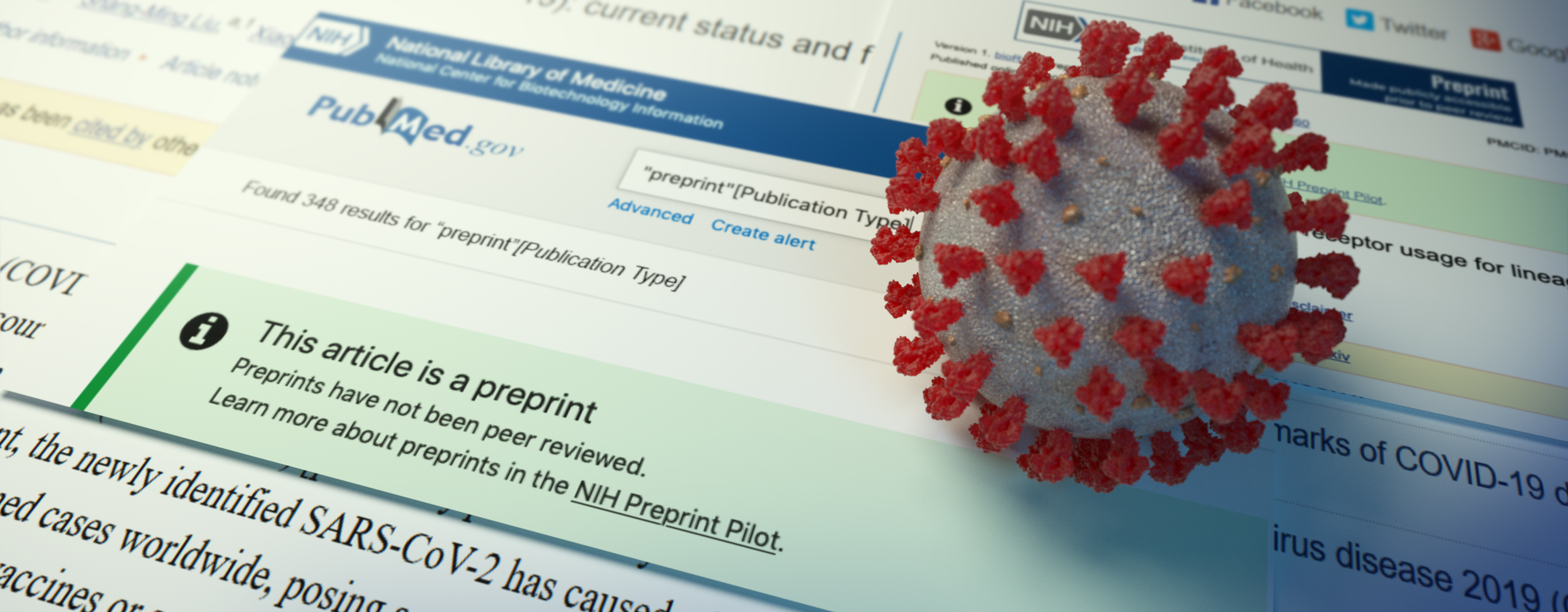4 Comments


Preprints – complete, public drafts of scientific documents that are not yet certified by peer reviewed – are playing a key role in accelerating dissemination of research on the SARS-CoV-2 virus and COVID-19, highlighting a need for broader discovery and distribution of early research results in literature searches. Responding to this urgent need, the National Library of Medicine (NLM) has launched the NIH Preprint Pilot, which will test the viability of making preprints searchable in PubMed Central (PMC) and discoverable in PubMed, starting with preprints reporting NIH-supported COVID-19 research. The pilot is expected to run for a minimum of 12 months, and lessons learned during that time will inform future NLM efforts with preprints
The NIH Preprint Pilot builds on the March 2017 NIH Guide Notice (NOT-OD-17-050) which encouraged NIH investigators to use interim research products, such as preprints, to speed the dissemination and enhance the rigor of their work. It also complements PMC’s role as the archive for peer-reviewed author manuscripts supported by NIH under the Public Access Policy, seeking to accelerate broad discovery to these results in cases where investigators choose to post a preprint.
NLM’s efforts for the first phase build on the work of the NIH Office of Portfolio Analysis iSearch COVID-19 Portfolio. NLM is using this resource to identify preprints reporting on COVID-19 research that are authored by NIH staff or by extramural grantees who acknowledge support of an NIH award. The initial COVID-19 collection of preprints added to PMC is expected to grow as curation workflows are refined and expanded.
In future phases, the NIH Preprint Pilot can be extended across the spectrum of NIH research. To minimize effort required by NIH-funded investigators to make their preprints discoverable via PMC, there will not be a new submission process or system to add preprints to PMC. Rather, NLM will work directly with preprint servers, and NIH-funded investigators are strongly encouraged to follow the preprint process outlined in the 2017 Guide Notice:
- Make the preprint publicly accessible (See also the “Guidance for selecting interim research product repositories” in the Guide Notice)
- Acknowledge NIH support/funding
- Clearly state the work is not peer reviewed
- Declare any competing interests
The notice also strongly encouraged awardees to select a Creative Commons Attribution (CC-BY) license or dedicate their work to the public domain.
NIH awardees can report preprints on their RPPR and link them to their award in their My Bibliography account. NLM will simplify how to add a preprint citation to My Bibliography in Summer 2020 with the expectation that the pilot will expand to include those preprints reported in My Bibliography as products of NIH awards in PMC. (For guidance on how to currently add a preprint to My Bibliography, see the NIH Preprint Pilot FAQ.)
For investigators looking for preprints, they will be integrated into your usual search results in PMC and PubMed. Both systems will make clear that the articles are preprints and not peer-reviewed journal articles. Prominent banners will explain that the papers have not been peer reviewed and link to information about the pilot for additional context. Users interested in only peer-reviewed articles will be able to filter out preprints from their search results.
In launching this new preprint experiment in PMC, with an initial focus on COVID-19-related preprints, NLM hopes to meet the needs of the research community during the ongoing public health emergency response efforts and to learn more about the impact of accelerated discovery and open sharing of research results on scholarly communications. NLM encourages NIH investigators to explore the pilot FAQs further and send feedback throughout to [email protected].



And the death of peer review and pubmed begins. Now anyone can get their thoughts into pubmed – any extremist on Twitter. Be prepared for a lot of offensive and wrong text arriving in pubmed.
I understand the desire to be agile in disseminating information and that defeating Covid-19 is very dependent on providing accurate information. However, there is already a lot of information available, much of it based on anecdotes, poorly constructed studies and inadequate science. Peer-review provides a quality check and adds validity. I do not think PubMed should stray from this important requirement, and thus help maintain the public trust.
How will this preprint or early publication interact with the Bayh Dole Act? It may render it ineffective. If prepublication is not thought about carefully, then University research will be dedicated to the public prior to any assessment of whether the publication of the technology should occur before or after IP protection is in place. In many instances, preprints discourage companies from use of the technology.
The primary goal of preprint is short sighted if it is only to get research to the public faster. The goal should not be that one dimensional. The goal must consider its impact on the benefits to society. Although fast research publication, sounds like a great goal at first blush; it is counterproductive to the primary goal of having federal research dollars result in reliable, accurate research on technology that benefits society. The goal should focus on research for society’s benefit. That should be the main goal. The implement of a preprint should be designed to release of accurate, reliable technology which should swiftly and if possible directly be used in a product to benefit society. However, what preprints as now envisioned incentivizes the opposite. Preprint incentivizes no use of the preprint technology or at best greatly reduced, and delayed, or indirect use of technology in the preprints. As envisioned preprints compromise the reliability, possibly the accuracy, and often the protectibility of the technological information. Each of these three are concerning, but hindering of the ability to generate IP protection for the technology in a product harms society most tangibly.
A company expects to generate a solid return on their R&D investments through sale of product. A company, in a regulated or competitive market, often needs a patented product to fund R&D and regulatory costs required to move technology, (in the preprint), into a product. Preprint encourages incomplete and unreviewed research to be dedicated to the public at a time prior to the technology being patentable. This preprint strategy does not often allow time for research to fully enable an invention, to assess patentablity of the technology, or whether foreign IP protection should be considered.
It may appear counter intuitive to fans of preprint, but early publication of technology often makes the technology less likely to used by a company in its product. Thus, less likely that the technology will be a benefit to the citizens of the US. Why? Because preprint publications, may lose all ability to receive IP protection on the technology. Technology that is published but is not a fully enabled invention in a preprint can act as a barrier to patent protection. Without IP rights to protect a company’s investment in a technology, the company is discouraged from spending efforts and R&D money on the development of that product. Both growing companies and large companies may have the capacity to develop a product directly using the technology in the preprint, but they both need IP protection to help with their return on investment in that product. Preprint eliminates or makes extremely unlikely that the technology will have this IP protection.
A preprint strategy that hinders patent rights in the technology, not only makes it less likely that a company of any size will make a product directly from the technology; but it also creates an uneven playing field in this technology for different sizes of companies. This uneven playing field favors larger companies.
Preprints of technology without IP rights discourages growing companies from development of products in that technology field. Without the period of exclusivity IP provides for a product, there are greater financial risks, and less potential returns on investment for the company. Growing companies when faced with development costs for a product that lacks a potential IP asset are stymied. With IP protection on the technology, a growing company can leverage investment, fund R&D capacity needed to swiftly develop a product. Without IP protection for the technology, they lack this leverage. Large companies have less need for this leverage but they still need IP on the product.
If a larger company has the resources to design a different patentable product from the technology in the preprint it may develop the technology, but develop it in a different form of product. Developing a patentable new form of product costs money and adds time. In contrast, many growing companies do not have the R&D resources to effectively ‘design a different product’ from the preprint technology which is patentable. Thus a preprint that hinder IP, discourages all companies. But it also makes an uneven playing field for growing companies, becauset the preprint does not provide as substantial a barrier to large companies with more time, resources and money to counter the built in IP problem associated with preprints of technology.
I am very passionate to keep in touch myself with recent research and global issues.